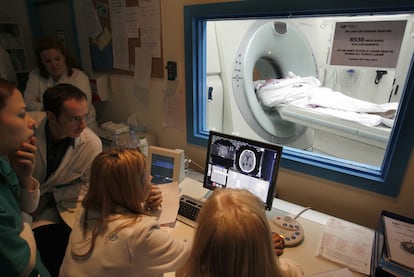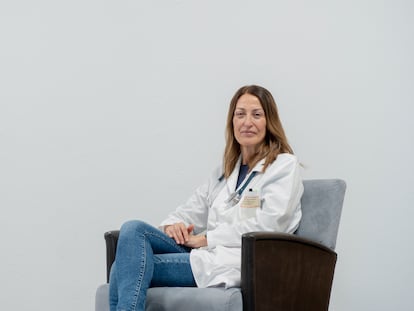Strokes will cause nearly 10 million deaths per year by 2050, mostly in poor countries
An aging population and unhealthy lifestyle habits among young people are the main causes of the increase

According to a study published in the journal The Lancet Neurology, the incidence of stroke has doubled in the past 30 years, and by 2050 almost 10 million people worldwide will die from stroke. A stroke occurs suddenly, without warning, and the time it takes to react and seek treatment is essential for minimizing its consequences.
“The incidence of stroke is increasing due to several factors, such as the aging of the population worldwide [and] the increase in cases of hypertension, diabetes and obesity,” explains Dr. Jeyaraj Pandian, the president of the World Stroke Organization (WSO) who participated in writing the article. In addition to analyzing the causes of this increase in different social contexts, the experts offer strategies for mitigating the incidence of this disease, which can decrease exponentially with prevention. “Through education and timely access to effective treatments, it is possible to address the emerging challenges associated with the health of our nervous system,” says Dr. Pandian. “The problem is that these precautions will not have the same effect everywhere in the world.”
The incidence of stroke is poised to increase globally, as is the gap between countries with greater and fewer resources. It is estimated that deaths in low- and middle-income countries will increase from 5.7 million in 2020 to 8.8 million in 2050, while in high-income countries they are expected to remain virtually unchanged (stroke-related deaths in wealthy countries will account for only 9% of global deaths, while 91% will occur in the poorest countries).
“Healthcare systems in [poorer] countries often face significant challenges, such as the lack of resources for access to quality medical care, in both the prevention and acute phases,” says Pandian. The researcher explains that these difficulties are compounded by other brain infections that can lead to stroke, such as AIDS, dengue fever and tuberculosis, which are more common in low- and middle-income countries.
According to the study, Southeast Asian countries recorded the highest proportion of stroke deaths globally in 2020 (61%, about 4.1 million deaths), and this figure is predicted to rise to 69% by 2050. “Without urgent action, stroke deaths in Southeast Asia, East Asia and Oceania could increase by almost 2 million people, from 3.1 million in 2020 to potentially 4.9 million in 2050,″ Pandian emphasizes.
Risk factors
According to data from the Spanish Society of Neurology (SEN), there will also be a 34% increase in the number of strokes in Europe, and a 45% increase in deaths, although those increases are less than in poorer countries. In Spain, where one in four people is destined to suffer a stroke in their lifetime, at least 17,000 patients die each year, while around 30,000 are left in a functionally dependent state. “It is clear that in Spain we are in a privileged situation compared to the countries with fewer resources that are analyzed in the study,” acknowledges Dr. Mar Freijo, the coordinator of the SEN Cerebrovascular Disease Study Group. “We have a national strategy and other action plans that work, although there is clearly room for improvement, especially in terms of awareness and education,” she adds.
Controlling risk factors is the most effective way to prevent stroke mortality. The most important threats are hypertension (the number of people between the ages of 30 and 79 who have that condition has doubled in the last 30 years), diabetes, high cholesterol levels, obesity, an unhealthy diet, a sedentary lifestyle and smoking, although Freijo argues that age is still the most important risk factor: “We must not forget that 60% of cases occur in people over 70 years of age, and only 16% in people under 50.″
While the Lancet study shows that the overall mortality rate among people over 60 years of age will decline by 36%, the rate is projected to decline by less than 25% among those younger than 60 years of age. The reason for this smaller decline among younger people could be related to rising levels of diabetes and obesity in this age group. “Younger people think that this is something that only affects older people, and that is why they have less healthy lifestyle habits and don’t take care of themselves as well. Basically, this is because the risk factors are not treated, although age is still the most important factor of all,” explains Dr. Joan Martí-Fàbregas, the director of the stroke unit at the Sant Pau Hospital in Barcelona, Spain.
Four phases for prevention and action
In addition to offering a quantitative study of the incidence of stroke and its cost to the healthcare system, the article stresses the need to increase resources in the disease’s four therapeutic phases: primary prevention; the acute phase, which takes place in hospital after the patient has suffered a stroke; secondary prevention, which is targeted at those who have already had a stroke; and rehabilitation, which is essential for limiting the stroke’s aftereffects.
Dr. Elena López-Cancio, who works in the Stroke Unit at the Hospital Universitario Central de Asturias (Asturias Central University Hospital), recognizes that Spain has a highly developed system for treating the acute phase. “The number of stroke units has been growing over the years, and our public health system means that stroke will be fatal to a much lesser degree than in the other countries analyzed in the study,” she says. Even so, she recognizes the need to improve prevention. “There is a need to educate the population; in many cases, [people are] unaware of the measures they need to adopt to maintain a healthy lifestyle,” she explains. “But it is also necessary to increase economic resources to guarantee rehabilitation in public hospitals, since in some cases patients are forced to resort to private hospitals.”
How to recognize the symptoms of a stroke
There are several symptoms that indicate that a person might be having a stroke, and they all appear suddenly. Recognizing them is essential for wasting as little time as possible and minimizing the aftereffects once the acute phase is over. "Acting quickly is essential when treating a stroke, which is why we use the FAST method; it reminds us that time is of the essence," explains Dr. Martí-Fàbregas.
- F (face): make the patient smile to see if one side of his or her mouth droops or is numb, which would indicate that he or she is losing muscle tone;
- A (arms): ask the person to lift each limb together and separately, as a person having a stroke may have one side of the body that is weak or numb;
- S (speech): stroke can cause language disorder, which manifests itself in the inability to speak coherently or to understand what others are saying;
- T (time): act without delay.
Although it may seem counterintuitive, once any of these anomalies has been detected, one should not rush to a hospital, as not all structures are equipped to treat this disease. "What you have to do is call 911, describe the symptoms and wait for them to send an ambulance that will take you to a hospital with a stroke unit. Going randomly to a hospital that does not have the necessary resources will only waste time," the doctor says.
Sign up for our weekly newsletter to get more English-language news coverage from EL PAÍS USA Edition










































